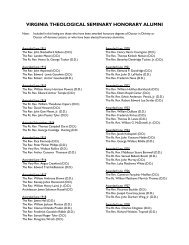Seminary Journal 2008 (August) - Virginia Theological Seminary
Seminary Journal 2008 (August) - Virginia Theological Seminary
Seminary Journal 2008 (August) - Virginia Theological Seminary
Create successful ePaper yourself
Turn your PDF publications into a flip-book with our unique Google optimized e-Paper software.
purposes, such as fi lling the taps in<br />
our homes.<br />
What about poorer countries? There<br />
will still be a case for large reservoirs<br />
in some parts of the world. At a World<br />
Water Forum, held in Mexico City<br />
last year, engineers, politicians, and<br />
fi nanciers from round the world called<br />
for investment in more large dams to<br />
meet growing demand for water.<br />
But there are serious questions about<br />
how much dams can do. What is the<br />
point of more dams when the rivers<br />
are already drying up? A global study<br />
published last week showed that a<br />
quarter of the world’s population<br />
already lives in river basins where<br />
the water is already fully allocated or<br />
over-allocated. New developments in<br />
these areas will only take water from<br />
some users and give it to others.<br />
What else? Well, moving water from<br />
one river system to another—from wet<br />
areas to dry areas—is possible. But it<br />
is very expensive—both to build and<br />
in pumping costs. China is currently<br />
spending $60 billion on a series of vast<br />
canals to pump water from the wet<br />
south to the arid north. India is talking<br />
about trucking water from the great<br />
monsoon rivers of the north, like the<br />
Ganges, to the dry south and west. But<br />
the price tag for construction alone is<br />
a cool $200 billion. Australians discuss<br />
massive canals or pipes to bring water<br />
south from the monsoon lands of the<br />
north. Even Britain from time to time<br />
considers building a national water<br />
grid to connect the wet northwest to<br />
the dry southeast.<br />
All this could be good business for<br />
engineers, but I suspect will rarely be<br />
the answer for consumers. The Austra-<br />
lian schemes being discussed currently<br />
work out to be more costly than<br />
desalinated seawater. Farmers could<br />
never afford their product.<br />
But we do need some answers, and<br />
soon. Economists estimate that by<br />
2025, with current water use patterns<br />
and growing population, water scarcity<br />
will be cutting global food production<br />
by 350 million tons a year. That is<br />
rather more than the current U.S. grain<br />
harvest, and the equivalent of a loaf of<br />
bread every week for every person on<br />
the planet. For hundreds of millions of<br />
people, that disappearing loaf may be<br />
the only one they get.<br />
One other thing: If the world gets<br />
into growing biofuels to reduce our<br />
reliance on oil and cut greenhouse gas<br />
emissions—say by converting a quarter<br />
of its fuels to biofuel—that would<br />
effectively double our water demand<br />
for crops.<br />
I think two things need to happen.<br />
First, we need to get better at catching<br />
the rain where it falls and before it<br />
disperses. We need a modern version<br />
of the old water butt catching rainfall<br />
off the roof for use in the garden. It’s<br />
not rocket science.<br />
In researching my book, I visited villages<br />
across India and China where they<br />
are doing just this—reviving ancient<br />
methods of capturing the rain as it falls,<br />
and pouring it down their wells.<br />
Secondly, there needs to be a massive<br />
revolution in the way we use water.<br />
Most homes can make big savings. So<br />
can most water companies, by reducing<br />
leaks. In most of the world’s cities,<br />
between a quarter and a half of the<br />
water put into distributions networks<br />
never reaches customers because it<br />
leaks away.<br />
Similarly, we need to reduce the vast<br />
losses from evaporation at reservoirs.<br />
Did you know, for instance, that more<br />
water evaporates from behind the<br />
High Aswan Dam on the Nile in Egypt<br />
than is delivered to homes and factories<br />
throughout Britain in a year?<br />
And much, much more urban waste<br />
water should be recycled to make<br />
clean drinking water. Some people<br />
have an antipathy to this. The yuck<br />
factor. But in London we have been<br />
doing it for decades. We are drinking<br />
water excreted by the people of Swindon<br />
and Oxford and Reading and<br />
all down the Thames. The fact that<br />
they put it back into the river briefl y<br />
before we take it out again doesn’t<br />
alter the fact.<br />
Most industries can use water much<br />
more effi ciently. The biggest savings<br />
globally, however, have to be in<br />
agricultural irrigation, the biggest<br />
user of water, especially in the driest<br />
countries. Tens of millions of farmers<br />
worldwide still irrigate their crops<br />
by fl ooding their fi elds. Most of the<br />
water evaporates and little, in practice,<br />
reaches the plants. But cheap, modern<br />
systems of drip irrigation—delivering<br />
water drop by drop close to the crop<br />
roots—can cut water demand by 40 or<br />
50 percent or even, in some soils, 70 or<br />
80 percent.<br />
The simple truth is that, to protect our<br />
rivers and ensure water supplies in<br />
the future, we have to use less water.<br />
The days of seeing the stuff as a free<br />
resource, available in unlimited quantities<br />
as of right, must surely be over.<br />
64 VIRGINIA SEMINARY JOURNAL AUGUST 2007



